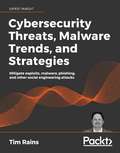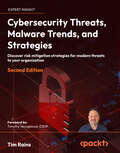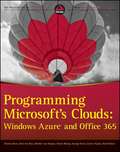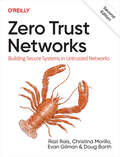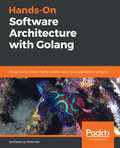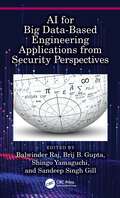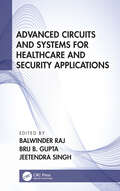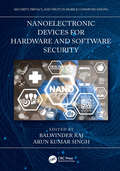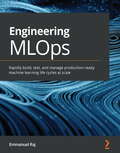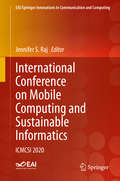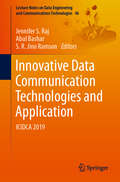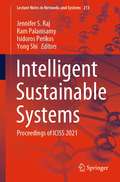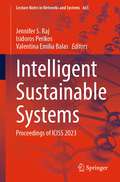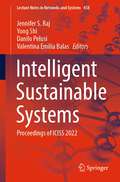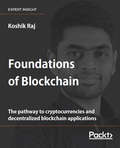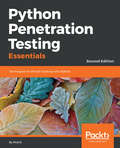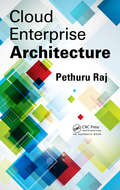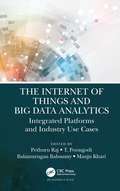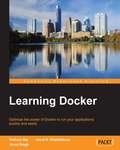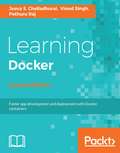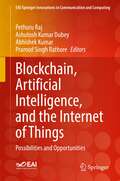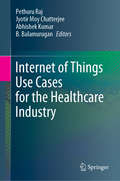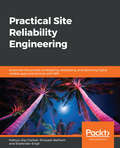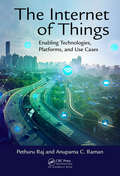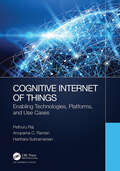- Table View
- List View
Cybersecurity Threats, Malware Trends, and Strategies: Mitigate exploits, malware, phishing, and other social engineering attacks
by Tim RainsAfter scrutinizing numerous cybersecurity strategies, Microsoft's former Global Chief Security Advisor provides unique insights on the evolution of the threat landscape and how enterprises can address modern cybersecurity challenges. Key Features Protect your organization from cybersecurity threats with field-tested strategies by the former most senior security advisor at Microsoft Discover the most common ways enterprises initially get compromised Measure the effectiveness of your organization's current cybersecurity program against cyber attacks Book Description Cybersecurity Threats, Malware Trends, and Strategies shares numerous insights about the threats that both public and private sector organizations face and the cybersecurity strategies that can mitigate them. The book provides an unprecedented long-term view of the global threat landscape by examining the twenty-year trend in vulnerability disclosures and exploitation, nearly a decade of regional differences in malware infections, the socio-economic factors that underpin them, and how global malware has evolved. This will give you further perspectives into malware protection for your organization. It also examines internet-based threats that CISOs should be aware of. The book will provide you with an evaluation of the various cybersecurity strategies that have ultimately failed over the past twenty years, along with one or two that have actually worked. It will help executives and security and compliance professionals understand how cloud computing is a game changer for them. By the end of this book, you will know how to measure the effectiveness of your organization's cybersecurity strategy and the efficacy of the vendors you employ to help you protect your organization and yourself. What you will learn Discover cybersecurity strategies and the ingredients critical to their success Improve vulnerability management by reducing risks and costs for your organization Learn how malware and other threats have evolved over the past decade Mitigate internet-based threats, phishing attacks, and malware distribution sites Weigh the pros and cons of popular cybersecurity strategies of the past two decades Implement and then measure the outcome of a cybersecurity strategy Learn how the cloud provides better security capabilities than on-premises IT environments Who this book is for This book is for senior management at commercial sector and public sector organizations, including Chief Information Security Officers (CISOs) and other senior managers of cybersecurity groups, Chief Information Officers (CIOs), Chief Technology Officers (CTOs) and senior IT managers who want to explore the entire spectrum of cybersecurity, from threat hunting and security risk management to malware analysis. Governance, risk, and compliance professionals will also benefit. Cybersecurity experts that pride themselves on their knowledge of the threat landscape will come to use this book as a reference.
Cybersecurity Threats, Malware Trends, and Strategies: Discover risk mitigation strategies for modern threats to your organization, 2nd Edition
by Tim Rains Timothy Youngblood CISSPImplement effective cybersecurity strategies to help you and your security team protect, detect, and respond to modern-day threatsPurchase of the print or Kindle book includes a free eBook in PDF format.Key FeaturesProtect your organization from cybersecurity threats with field-tested strategiesUnderstand threats such as exploits, malware, internet-based threats, and governmentsMeasure the effectiveness of your organization's current cybersecurity program against modern attackers' tacticsBook DescriptionTim Rains is Microsoft's former Global Chief Security Advisor and Amazon Web Services' former Global Security Leader for Worldwide Public Sector. He has spent the last two decades advising private and public sector organizations all over the world on cybersecurity strategies.Cybersecurity Threats, Malware Trends, and Strategies, Second Edition builds upon the success of the first edition that has helped so many aspiring CISOs, and cybersecurity professionals understand and develop effective data-driven cybersecurity strategies for their organizations. In this edition, you'll examine long-term trends in vulnerability disclosures and exploitation, regional differences in malware infections and the socio-economic factors that underpin them, and how ransomware evolved from an obscure threat to the most feared threat in cybersecurity. You'll also gain valuable insights into the roles that governments play in cybersecurity, including their role as threat actors, and how to mitigate government access to data. The book concludes with a deep dive into modern approaches to cybersecurity using the cloud.By the end of this book, you will have a better understanding of the threat landscape, how to recognize good Cyber Threat Intelligence, and how to measure the effectiveness of your organization's cybersecurity strategy.What you will learnDiscover enterprise cybersecurity strategies and the ingredients critical to their successImprove vulnerability management by reducing risks and costs for your organizationMitigate internet-based threats such as drive-by download attacks and malware distribution sitesLearn the roles that governments play in cybersecurity and how to mitigate government access to dataWeigh the pros and cons of popular cybersecurity strategies such as Zero Trust, the Intrusion Kill Chain, and othersImplement and then measure the outcome of a cybersecurity strategyDiscover how the cloud can provide better security and compliance capabilities than on-premises IT environmentsWho this book is forThis book is for anyone who is looking to implement or improve their organization's cybersecurity strategy. This includes Chief Information Security Officers (CISOs), Chief Security Officers (CSOs), compliance and audit professionals, security architects, and cybersecurity professionals. Basic knowledge of Information Technology (IT), software development principles, and cybersecurity concepts is assumed.
Programming Microsoft's Clouds
by Razi Bin Rais Thomas Rizzo Darrin Bishop George Durzi Zoiner Tejada David Mann Michiel Van OtegemA detailed look at a diverse set of Cloud topics, particularly Azure and Office 365More and more companies are realizing the power and potential of Cloud computing as a viable way to save energy and money. This valuable book offers an in-depth look at a wide range of Cloud topics unlike any other book on the market. Examining how Cloud services allows users to pay as they go for exactly what they use, this guide explains how companies can easily scale their Cloud use up and down to fit their business requirements. After an introduction to Cloud computing, you'll discover how to prepare your environment for the Cloud and learn all about Office 365 and Azure.Examines a diverse range of Cloud topics, with special emphasis placed on how Cloud computing can save businesses energy and moneyShows you how to prepare your environment for the CloudAddresses Office 365, including infrastructure services, SharePoint 2010 online, SharePoint online development, Exchange online development, and Lync online developmentDiscusses working with Azure, including setting it up, leveraging Blob storage, building Azure applications, programming, and debuggingOffers advice for deciding when to use Azure and when to use Office 365 and looks at hybrid solutions between Azure and Office 365Tap into the potential of Azure and Office 365 with this helpful resource.
Zero Trust Networks
by Razi Rais Christina Morillo Evan Gilman Doug BarthThis practical book provides a detailed explanation of the zero trust security model. Zero trust is a security paradigm shift that eliminates the concept of traditional perimeter-based security and requires you to "always assume breach" and "never trust but always verify." The updated edition offers more scenarios, real-world examples, and in-depth explanations of key concepts to help you fully comprehend the zero trust security architecture.Examine fundamental concepts of zero trust security model, including trust engine, policy engine, and context aware agentsUnderstand how this model embeds security within the system's operation, with guided scenarios at the end of each chapterMigrate from a perimeter-based network to a zero trust network in productionExplore case studies that provide insights into organizations' zero trust journeysLearn about the various zero trust architectures, standards, and frameworks developed by NIST, CISA, DoD, and others
Hands-On Software Architecture with Golang: Design And Architect Highly Scalable And Robust Applications Using Go
by Jyotiswarup RaiturkarThis book is for software developers, architects and CTOs looking to use Go in their software architecture. The book assumes general programming knowledge and architecture concepts. Familiarity with Go is not required and programming constructs are introduced with concepts.
AI for Big Data-Based Engineering Applications from Security Perspectives
by Balwinder RajArtificial intelligence (AI), machine learning, and advanced electronic circuits involve learning from every data input and using those inputs to generate new rules for future business analytics. AI and machine learning are now giving us new opportunities to use big data that we already had, as well as unleash a whole lot of new use cases with new data types. With the increasing use of AI dealing with highly sensitive information such as healthcare, adequate security measures are required to securely store and transmit this information. This book provides a broader coverage of the basic aspects of advanced circuits design and applications. AI for Big Data-Based Engineering Applications from Security Perspectives is an integrated source that aims at understanding the basic concepts associated with the security of advanced circuits. The content includes theoretical frameworks and recent empirical findings in the field to understand the associated principles, key challenges, and recent real-time applications of advanced circuits, AI, and big data security. It illustrates the notions, models, and terminologies that are widely used in the area of Very Large Scale Integration (VLSI) circuits, security, identifies the existing security issues in the field, and evaluates the underlying factors that influence system security. This work emphasizes the idea of understanding the motivation behind advanced circuit design to establish the AI interface and to mitigate security attacks in a better way for big data. This book also outlines exciting areas of future research where already existing methodologies can be implemented. This material is suitable for students, researchers, and professionals with research interest in AI for big data–based engineering applications, faculty members across universities, and software developers.
Advanced Circuits and Systems for Healthcare and Security Applications
by Balwinder Raj Brij B. Gupta Jeetendra SinghVLSI devices downscaling is a very significant part of the design to improve the performance of VLSI industry outcomes, which results in high speed and low power of operation of integrated devices. The increasing use of VLSI circuits dealing with highly sensitive information, such as healthcare information, means adequate security measures are required to be taken for the secure storage and transmission. Advanced Circuits and Systems for Healthcare and Security Applications provides broader coverage of the basic aspects of advanced circuits and security and introduces the corresponding principles. By the end of this book, you will be familiarized with the theoretical frameworks, technical methodologies, and empirical research findings in the field to protect your computers and information from adversaries. Advanced circuits and the comprehensive material of this book will keep you interested and involved throughout. The book is an integrated source which aims at understanding the basic concepts associated with the security of the advanced circuits and the cyber world as a first step towards achieving high-end protection from adversaries and hackers. The content includes theoretical frameworks and recent empirical findings in the field to understand the associated principles, key challenges and recent real-time applications of the advanced circuits and cybersecurity. It illustrates the notions, models, and terminologies that are widely used in the area of circuits and security, identifies the existing security issues in the field, and evaluates the underlying factors that influence the security of the systems. It emphasizes the idea of understanding the motivation of the attackers to establish adequate security measures and to mitigate security attacks in a better way. This book also outlines the exciting areas of future research where the already-existing methodologies can be implemented. Moreover, this book is suitable for students, researchers, and professionals in the who are looking forward to carry out research in the field of advanced circuits and systems for healthcare and security applications; faculty members across universities; and software developers.
Nanoelectronic Devices for Hardware and Software Security (Security, Privacy, and Trust in Mobile Communications)
by Balwinder Raj Arun Kumar SinghNanoelectronic Devices for Hardware and Software Security has comprehensive coverage of the principles, basic concepts, structure, modeling, practices, and circuit applications of nanoelectronics in hardware/software security. It also covers the future research directions in this domain. In this evolving era, nanotechnology is converting semiconductor devices dimensions from micron technology to nanotechnology. Nanoelectronics would be the key enabler for innovation in nanoscale devices, circuits, and systems. The motive for this research book is to provide relevant theoretical frameworks that include device physics, modeling, circuit design, and the latest developments in experimental fabrication in the field of nanotechnology for hardware/software security. There are numerous challenges in the development of models for nanoscale devices (e.g., FinFET, gate-all-around devices, TFET, etc.), short channel effects, fringing effects, high leakage current, and power dissipation, among others. This book will help to identify areas where there are challenges and apply nanodevice and circuit techniques to address hardware/software security issues.
MLOps using Azure Machine Learning: Rapidly build, test, and manage production-ready machine learning life cycles at scale
by Emmanuel RajThis book is for data scientists, software engineers, DevOps engineers, and machine learning developers who want to build, deploy, and maintain ML systems in production efficiently using MLOps principles and techniques. Basic knowledge of machine learning is required.
International Conference on Mobile Computing and Sustainable Informatics: ICMCSI 2020 (EAI/Springer Innovations in Communication and Computing)
by Jennifer S. RajSustainability and mobile computing embraces a wide range of Information and Communication Technologies [ICT] in recent times. This book focuses more on the recent research and development works in almost all the facets of sustainable, ubiquitous computing and communication paradigm. The recent research efforts on this evolving paradigm help to advance the technologies for next-generation, where socio-economic growth and sustainability poses significant challenges to the computing and communication infrastructures. The main purpose of this book is to promote the technical advances and impacts of sustainability and mobile computing to the informatics research. The key strands of this book include green computing, predictive models, mobility, data analytics, mobile computing, optimization, Quality of Service [QoS], new communicating and computing frameworks, human computer interaction, Artificial Intelligence [AI], communication networks, risk management, Ubiquitous computing, robotics, smart city and applications. The book has also addressed myriad of sustainability challenges in various computing and information processing infrastructures.
Innovative Data Communication Technologies and Application: ICIDCA 2019 (Lecture Notes on Data Engineering and Communications Technologies #46)
by Jennifer S. Raj Abul Bashar S. R. Jino RamsonThis book presents emerging concepts in data mining, big data analysis, communication, and networking technologies, and discusses the state-of-the-art in data engineering practices to tackle massive data distributions in smart networked environments. It also provides insights into potential data distribution challenges in ubiquitous data-driven networks, highlighting research on the theoretical and systematic framework for analyzing, testing and designing intelligent data analysis models for evolving communication frameworks.Further, the book showcases the latest developments in wireless sensor networks, cloud computing, mobile network, autonomous systems, cryptography, automation, and other communication and networking technologies. In addition, it addresses data security, privacy and trust, wireless networks, data classification, data prediction, performance analysis, data validation and verification models, machine learning, sentiment analysis, and various data analysis techniques.
Intelligent Sustainable Systems: Proceedings of ICISS 2021 (Lecture Notes in Networks and Systems #213)
by Jennifer S. Raj Ram Palanisamy Isidoros Perikos Yong ShiThis book features research papers presented at the 4th International Conference on Intelligent Sustainable Systems (ICISS 2021), held at SCAD College of Engineering and Technology, Tirunelveli, Tamil Nadu, India, during February 26–27, 2021. The book discusses the latest research works that discuss the tools, methodologies, practices, and applications of sustainable systems and computational intelligence methodologies. The book is beneficial for readers from both academia and industry.
Intelligent Sustainable Systems: Proceedings of ICISS 2023 (Lecture Notes in Networks and Systems #665)
by Jennifer S. Raj Isidoros Perikos Valentina Emilia BalasThis book features research papers presented at the 6th International Conference on Intelligent Sustainable Systems (ICISS 2023), held at SCAD College of Engineering and Technology, Tirunelveli, Tamil Nadu, India, during February 2–3, 2023. The book reports research results on the development and implementation of novel systems, technologies, and applications that focus on the advancement of sustainable living. The chapters included in this book discuss a spectrum of related research issues such as applications of intelligent computing practices that can have ecological and societal impacts. Moreover, this book emphasizes on the state-of-the-art networked and intelligent technologies that are influencing a promising development in the direction of a long-term sustainable future. The book is beneficial for readers from both academia and industry.
Intelligent Sustainable Systems: Proceedings of ICISS 2022 (Lecture Notes in Networks and Systems #458)
by Jennifer S. Raj Yong Shi Danilo Pelusi Valentina Emilia BalasThis book features research papers presented at the 5th International Conference on Intelligent Sustainable Systems (ICISS 2022), held at SCAD College of Engineering and Technology, Tirunelveli, Tamil Nadu, India, during February 17–18, 2022. The book discusses latest research works that discusses the tools, methodologies, practices, and applications of sustainable systems and computational intelligence methodologies. The book is beneficial for readers from both academia and industry.
Foundations of Blockchain: The pathway to cryptocurrencies and decentralized blockchain applications
by Koshik RajReaders should be comfortable with general security terms, but no knowledge of cryptography or decentralized application is assumed. Although the book begins with all the basic concepts, a hands-on python programming, and theoretical networking knowledge, would speed up the reading process.
Python Penetration Testing Essentials: Techniques for ethical hacking with Python, 2nd Edition
by Mohit RajThis book gives you the skills you need to use Python for penetration testing, with the help of detailed code examples. This book has been updated for Python 3.6.3 and Kali Linux 2018.1.Key FeaturesDetect and avoid various attack types that put the privacy of a system at riskLeverage Python to build efficient code and eventually build a robust environmentLearn about securing wireless applications and information gathering on a web serverBook DescriptionThis book gives you the skills you need to use Python for penetration testing (pentesting), with the help of detailed code examples. We start by exploring the basics of networking with Python and then proceed to network hacking. Then, you will delve into exploring Python libraries to perform various types of pentesting and ethical hacking techniques. Next, we delve into hacking the application layer, where we start by gathering information from a website. We then move on to concepts related to website hacking—such as parameter tampering, DDoS, XSS, and SQL injection.By reading this book, you will learn different techniques and methodologies that will familiarize you with Python pentesting techniques, how to protect yourself, and how to create automated programs to find the admin console, SQL injection, and XSS attacks.What you will learnThe basics of network pentesting including network scanning and sniffingWireless, wired attacks, and building traps for attack and torrent detectionWeb server footprinting and web application attacks, including the XSS and SQL injection attackWireless frames and how to obtain information such as SSID, BSSID, and the channel number from a wireless frame using a Python scriptThe importance of web server signatures, email gathering, and why knowing the server signature is the first step in hackingWho this book is forIf you are a Python programmer, a security researcher, or an ethical hacker and are interested in penetration testing with the help of Python, then this book is for you. Even if you are new to the field of ethical hacking, this book can help you find the vulnerabilities in your system so that you are ready to tackle any kind of attack or intrusion.
Cloud Enterprise Architecture
by Pethuru RajCloud Enterprise Architecture examines enterprise architecture (EA) in the context of the surging popularity of Cloud computing. It explains the different kinds of desired transformations the architectural blocks of EA undergo in light of this strategically significant convergence. Chapters cover each of the contributing architectures of EA-business, information, application, integration, security, and technology-illustrating the current and impending implications of the Cloud on each. Discussing the implications of the Cloud paradigm on EA, the book details the perceptible and positive changes that will affect EA design, governance, strategy, management, and sustenance. The author ties these topics together with chapters on Cloud integration and composition architecture. He also examines the Enterprise Cloud, Federated Clouds, and the vision to establish the InterCloud. Laying out a comprehensive strategy for planning and executing Cloud-inspired transformations, the book: Explains how the Cloud changes and affects enterprise architecture design, governance, strategy, management, and sustenance Presents helpful information on next-generation Cloud computing Describes additional architectural types such as enterprise-scale integration, security, management, and governance architectures This book is an ideal resource for enterprise architects, Cloud evangelists and enthusiasts, and Cloud application and service architects. Cloud center administrators, Cloud business executives, managers, and analysts will also find the book helpful and inspirational while formulating appropriate mechanisms and schemes for sound modernization and migration of traditional applications to Cloud infrastructures and platforms.
The Internet of Things and Big Data Analytics: Integrated Platforms and Industry Use Cases
by Pethuru RajThis book comprehensively conveys the theoretical and practical aspects of IoT and big data analytics with the solid contributions from practitioners as well as academicians. This book examines and expounds the unique capabilities of the big data analytics platforms in capturing, cleansing and crunching IoT device/sensor data in order to extricate actionable insights. A number of experimental case studies and real-world scenarios are incorporated in this book in order to instigate our book readers. This book Analyzes current research and development in the domains of IoT and big data analytics Gives an overview of latest trends and transitions happening in the IoT data analytics space Illustrates the various platforms, processes, patterns, and practices for simplifying and streamlining IoT data analytics The Internet of Things and Big Data Analytics: Integrated Platforms and Industry Use Cases examines and accentuates how the multiple challenges at the cusp of IoT and big data can be fully met. The device ecosystem is growing steadily. It is forecast that there will be billions of connected devices in the years to come. When these IoT devices, resource-constrained as well as resource-intensive, interact with one another locally and remotely, the amount of multi-structured data generated, collected, and stored is bound to grow exponentially. Another prominent trend is the integration of IoT devices with cloud-based applications, services, infrastructures, middleware solutions, and databases. This book examines the pioneering technologies and tools emerging and evolving in order to collect, pre-process, store, process and analyze data heaps in order to disentangle actionable insights.
Learning Docker
by Pethuru Raj Jeeva S. Chelladhurai Vinod Singh<P><P>Optimize the power of Docker to run your applications quickly and easily <P><P>About This Book <P><P>Learn to compose, use, and publish the Docker containers <P><P>Leverage the features of Docker to deploy your existing applications <P><P>Explore real world examples of securing and managing Docker containers <P><P>Who This Book Is For <P><P>If you are an application developer who wants to learn Docker in order to utilize its features for application deployment, then this book is for you. No prior knowledge of Docker is required. <P><P>What You Will Learn <P><P>Build a Docker image using Dockerfiles <P><P>Push and publish images on Docker Hub <P><P>Run your own private Docker Hub and upload images onto it <P><P>Create and run services inside a container to deploy your applications with ease <P><P>Share data between the Docker host and containers <P><P>Orchestrate multiple containers with Docker Compose <P><P>Test and debug applications inside a Docker container <P><P>Secure your Docker containers with SELinux <P><P>In Detail <P><P>Docker is a next-generation platform for simplifying application containerization life-cycle. Docker allows you to create a robust and resilient environment in which you can generate portable, composable, scalable, and stable application containers. <P><P>This book is a step-by-step guide that will walk you through the various features of Docker from Docker software installation to the impenetrable security of containers. The book starts off by elucidating the installation procedure for Docker and a few troubleshooting techniques. You will be introduced to the process of downloading Docker images and running them as containers. You'll learn how to run containers as a service (CaaS) and also discover how to share data among containers. Later on, you'll explore how to establish the link between containers and orchestrate containers using Docker Compose. You will also come across relevant details about application testing inside a container. You will discover how to debug a container using the docker exec command and the nsenter tool. Finally, you will learn how to secure your containers with SELinux and other proven methods.
Learning Docker - Second Edition
by Pethuru Raj Jeeva S. Chelladhurai Vinod SinghDocker lets you create, deploy, and manage your applications anywhere at anytime – flexibility is key so you can deploy stable, secure, and scalable app containers across a wide variety of platforms and delve into microservices architecture About This Book • This up-to-date edition shows how to leverage Docker's features to deploy your existing applications • Learn how to package your applications with Docker and build, ship, and scale your containers • Explore real-world examples of securing and managing Docker containers Who This Book Is For This book is ideal for developers, operations managers, and IT professionals who would like to learn about Docker and use it to build and deploy container-based apps. No prior knowledge of Docker is expected. What You Will Learn • Develop containerized applications using the Docker version 17.03 • Build Docker images from containers and launch them • Develop Docker images and containers leveraging Dockerfiles • Use Docker volumes to share data • Get to know how data is shared between containers • Understand Docker Jenkins integration • Gain the power of container orchestration • Familiarize yourself with the frequently used commands such as docker exec, docker ps, docker top, and docker stats In Detail Docker is an open source containerization engine that offers a simple and faster way for developing and running software. Docker containers wrap software in a complete filesystem that contains everything it needs to run, enabling any application to be run anywhere – this flexibily and portabily means that you can run apps in the cloud, on virtual machines, or on dedicated servers. This book will give you a tour of the new features of Docker and help you get started with Docker by building and deploying a simple application. It will walk you through the commands required to manage Docker images and containers. You'll be shown how to download new images, run containers, list the containers running on the Docker host, and kill them. You'll learn how to leverage Docker's volumes feature to share data between the Docker host and its containers – this data management feature is also useful for persistent data. This book also covers how to orchestrate containers using Docker compose, debug containers, and secure containers using the AppArmor and SELinux security modules. Style and approach This step-by-step guide will walk you through the features and use of Docker, from Docker software installation to the impenetrable security of containers.
Blockchain, Artificial Intelligence, and the Internet of Things: Possibilities and Opportunities (EAI/Springer Innovations in Communication and Computing)
by Pethuru Raj Ashutosh Kumar Dubey Abhishek Kumar Pramod Singh RathoreThis book provides basic concepts and deep knowledge about various security mechanisms that can be implemented in IoT through Blockchain technology. This book aids readers in gaining insight and knowledge about providing security and solutions to different challenges in IoT using Blockchain technology. This book primarily focuses on challenges to addressing the integration of the IoT with Blockchain with respect to potential benefits for IoT. This book gives descriptive analysis of Blockchain integrated with IoT applications and platforms for the development of IoT solutions along with possible topologies to that integration. Several application examples are included in a variety of industries.
Internet of Things Use Cases for the Healthcare Industry
by Pethuru Raj Abhishek Kumar Jyotir Moy Chatterjee B. BalamuruganThis book explores potentially disruptive and transformative healthcare-specific use cases made possible by the latest developments in Internet of Things (IoT) technology and Cyber-Physical Systems (CPS). Healthcare data can be subjected to a range of different investigations in order to extract highly useful and usable intelligence for the automation of traditionally manual tasks. In addition, next-generation healthcare applications can be enhanced by integrating the latest knowledge discovery and dissemination tools. These sophisticated, smart healthcare applications are possible thanks to a growing ecosystem of healthcare sensors and actuators, new ad hoc and application-specific sensor and actuator networks, and advances in data capture, processing, storage, and mining. Such applications also take advantage of state-of-the-art machine and deep learning algorithms, major strides in artificial and ambient intelligence, and rapid improvements in the stability and maturity of mobile, social, and edge computing models.
Practical Site Reliability Engineering
by Pethuru Raj Saravanan Pitchaimani Babu JayarajThis book will be a learning guide to help software developers, IT operational guys, DevOps engineers, performance specialists, and system engineers to understand how the emerging domain of SRE comes handy in automating and accelerating the process of designing, developing, debugging, deploying and delivering highly reliable applications and services.
The Internet of Things: Enabling Technologies, Platforms, and Use Cases
by Pethuru Raj Anupama C. RamanAs more and more devices become interconnected through the Internet of Things (IoT), there is an even greater need for this book,which explains the technology, the internetworking, and applications that are making IoT an everyday reality. The book begins with a discussion of IoT "ecosystems" and the technology that enables them, which includes: Wireless Infrastructure and Service Discovery Protocols Integration Technologies and Tools Application and Analytics Enablement Platforms A chapter on next-generation cloud infrastructure explains hosting IoT platforms and applications. A chapter on data analytics throws light on IoT data collection, storage, translation, real-time processing, mining, and analysis, all of which can yield actionable insights from the data collected by IoT applications. There is also a chapter on edge/fog computing. The second half of the book presents various IoT ecosystem use cases. One chapter discusses smart airports and highlights the role of IoT integration. It explains how mobile devices, mobile technology, wearables, RFID sensors, and beacons work together as the core technologies of a smart airport. Integrating these components into the airport ecosystem is examined in detail, and use cases and real-life examples illustrate this IoT ecosystem in operation. Another in-depth look is on envisioning smart healthcare systems in a connected world. This chapter focuses on the requirements, promising applications, and roles of cloud computing and data analytics. The book also examines smart homes, smart cities, and smart governments. The book concludes with a chapter on IoT security and privacy. This chapter examines the emerging security and privacy requirements of IoT environments. The security issues and an assortment of surmounting techniques and best practices are also discussed in this chapter.
Cognitive Internet of Things: Enabling Technologies, Platforms, and Use Cases
by Pethuru Raj Anupama C. Raman Harihara SubramanianThe Internet of Things (IoT) concept is defined as a flexible and futuristic network where all the different types of devices and smart objects can become seamlessly connected to each other and can actively participate in all types of processes which are happening around us. The grand objective of making physical, mechanical, electrical, and electronic devices to use the deeper and extreme connectivity and service-enablement techniques is to make them intelligent in their deeds, decisions, and deals. Cognitive IoT is the application of cognitive computing technologies to the data which is generated by the connected devices of the IoT ecosystem. Cognition means thinking; however, computers are not yet fully capable of mimicking human like thought. However, the present-day computer systems can perform some functions which are like the capability of human beings to think. Cognitive Internet of Things: Enabling Technologies, Platforms, and Use Cases explains the concepts surrounding Cognitive IoT. It also looks at the use cases and such supporting technologies as artificial intelligence and machine learning that act as key enablers of Cognitive IoT ecosystem. Different Cognitive IoT enabled platforms like IBM Watson and other product specific use cases like Amazon Alexa are covered in depth. Other highlights of the book include: Demystifying the cognitive computing paradigm Delineating the key capabilities of cognitive cloud environments Deep learning algorithms for cognitive IoT solutions Natural language processing (NLP) methods for cognitive IoT systems Designing a secure infrastructure for cognitive IoT platforms and applications
